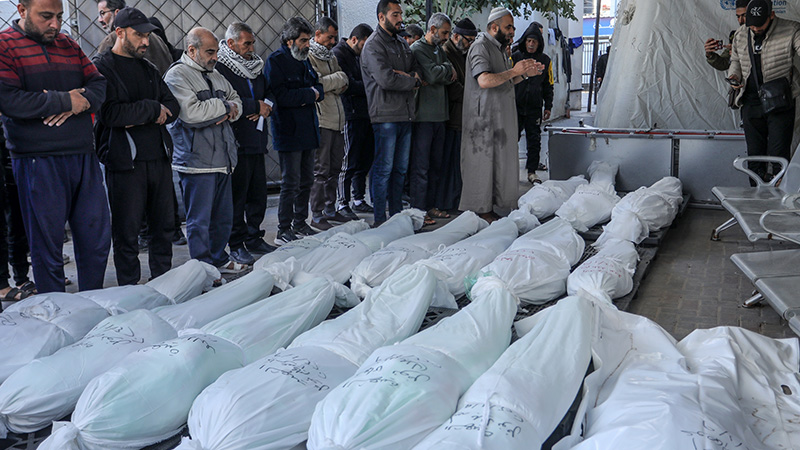The Lancet and the genocide by “slow death” in Gaza

A recent survey of Middle East scholars found that most view Israeli actions in Gaza since October 2023 as either “genocide” (34 percent) or “serious war crimes with genocide-like consequences” (41 percent). The survey authors point out that respondents have long followed the Israeli-Palestinian conflict and have a network of contacts among Palestinians and Israelis who provide them with information not available to the general public.
There have been objections to this characterization and the claim that Israel is acting within the framework of international law. Gaza’s Palestinians are certainly not being shoved into gas chambers or killed in mass firing squads. What leads Middle East scholars to this view is most likely the growing realization that Gazans are dying not only from direct killings in military operations, but also from a lack of livelihoods and medical care, exacerbated by the Israeli army’s repeated evacuation orders. On July 9, a group of special rapporteurs and independent experts – part of the Human Rights Council’s so-called Special Procedures – issued a statement saying “that Israel’s deliberate and targeted campaign of starvation against the Palestinian people is a form of genocide.”
What the Genocide Convention says
Death by conditions was specifically included in Article II of the Genocide Convention. The drafters were concerned that a population could be destroyed not only by killing (that is the term they used), but also by subjecting members of a group to conditions that, over time, lead to death. The drafters included both forms of “destruction”; one clause reads “killing members of the group” and another “deliberately inflicting on the group conditions of life calculated to bring about its physical destruction in whole or in part.”
An early draft of the Genocide Convention gave examples of the “conditions” that could constitute genocide, stating: “Subjection to conditions of life likely to result in debilitation or death due to lack of adequate shelter, clothing, food, hygiene and medical care, or excessive work or physical exertion.” The drafters explained what they meant in a comment immediately following that sentence, saying: “This could be described as ‘slow death.'” They went on to give an example of a situation in which “members of a group of people are placed in concentration camps where the annual mortality rate is 30 to 40 percent.” The drafters said such a situation would “obviously” indicate an intent to commit genocide, but clarified that they did not use 30 percent as the required mortality rate given the specific circumstances of each case.
In the final version of the “living conditions” provision, reference to “housing, clothing, food, hygiene and medical care, or excessive work or physical exertion” was deleted, apparently because the drafters did not want to limit “living conditions” to these specific deprivations. They probably wanted “living conditions” to apply to all conditions likely to lead to death.
The example of the concentration camps, however, reflected the circumstances of World War II that underpinned the Convention for the Prevention and Violation of the Crime of Genocide. There were camps such as Auschwitz and Treblinka, where many were killed immediately, but many others succumbed to the conditions. There was also the herding of the Jews of Warsaw into a ghetto, where the restriction of food and medical care led to death. It was conditions such as these that the authors called a “slow death.” In the Warsaw Ghetto, thousands died of starvation or of typhus and other infectious diseases during the three years it existed, from 1940 to 1943. The authors were closely connected to the events of the war. One of them was Raphael Lemkin, who had recently written a detailed study of Nazi practices in a book called Axis Rule in Occupied Europe. Lemkin and his colleagues must have known that a population could be effectively “destroyed” if deaths occurred over time, as individuals died away from public view.
Death toll in Gaza Strip
A study on Gaza published in early July in the British medical journal The Lancet bears a striking resemblance to what the authors of the Genocide Convention described. The authors – Rasha Khatib, Martin McKee and Salim Yusuf – estimate that there have been around 186,000 deaths in Gaza as a result of Israeli actions since October 2023, and most of these were not caused by bombings or executions.
The Lancet authors calculated the total death toll by adding a conservative estimate of four “indirect deaths” to one death caused by military action. They explained that
“Armed conflict has indirect health impacts that go beyond the direct harm caused by violence. Even if the conflict ends immediately, there will continue to be many indirect deaths in the coming months and years from causes such as reproductive, communicable and non-communicable diseases. Given the intensity of this conflict, the destroyed health infrastructure, the severe shortages of food, water and shelter, the inability of the population to flee to safe places and the loss of funding for UNRWA, one of the few humanitarian organizations still active in Gaza, the total death toll is expected to be high.”
The authors arrived at their conservative estimate by using figures on “indirect deaths” from other armed conflicts and “direct deaths” reported by the Gaza Ministry of Health. “In recent conflicts,” they wrote, “the number of such indirect deaths exceeded the number of direct deaths by between three and fifteen times. Applying a conservative estimate of four indirect deaths per direct death to the 37,396 (sic) reported deaths (at the time of publication), it is not implausible to estimate that up to 186,000 (sic) or even more deaths may be attributed to the current conflict in Gaza.”
As one can easily see, the methodology used in the Lancet study failed to provide an accurate death toll in Gaza for at least two reasons. The first is the number of deaths reported by the Gaza Ministry of Health, which may be an understatement due to the difficulties on the ground. The second is the use of the number “four” as a multiplier, which comes from a provision of the Secretariat of the 2008 Geneva Declaration on Direct and Indirect Deaths in Armed Conflict. On the other hand, the accuracy of the 186,000 figure obtained by the Lancet is not what matters. The point is that a large number of the deaths are caused by conditions that are not the result of mere military operations. For months, doctors working in the few remaining medical facilities in Gaza have reported that most of the deaths they see are not due to bombings but to “living conditions,” to use the terminology of the Genocide Convention. Babies and children in general dying of malnutrition account for some of the deaths. The lack of medical facilities and supplies is another reason. A doctor from Texas who worked for a time in a Gaza hospital told National Public Radio: “To see deaths like this that could have been prevented in America is heartbreaking because you are committed to saving someone’s life and you genuinely believe that you can save his or her life. But when the person dies, it’s like a shock because you can’t help them.”
Deaths from direct violence are undoubtedly a significant factor in Gaza. Bombing of civilian areas continues daily. In its case against Israel before the International Court of Justice, South Africa alleges both types of death. South Africa highlights those that fall under the two key clauses of the Genocide Convention, one on killing and the other on “conditions of life.” Nicaragua will also cite both types of death in its case against Germany before the same court over the supply of military equipment to Israel. Nicaragua will seek to prove that Israel is committing genocide.
In either case before the UN court, binding decisions will be made. But it is not only before the court that decisions must be made. According to the UN Charter, the Security Council has jurisdiction over wars, and if it does not, the General Assembly is supposed to step in and do so itself, under the “Uniting for Peace” procedure established during the Korean War. The Security Council is required by the Charter to enforce decisions of the court, which has already ruled that South Africa is a plausible case of genocide. The Genocide Convention itself provides that states that have signed the convention are obliged to prevent or stop genocide if it is committed anywhere in the world. UN member states that favor serious sanctions against Israel, such as cutting off trade or diplomatic relations, can make a stronger case by focusing on indirect deaths.
“Genocide” is a loaded word. It is particularly loaded when it is used against Israel, a state whose raison d’être is to prevent genocide against the Jews of the world. But the meaning of the term is clouded by the fact that in the public mind it is associated only with “direct deaths” of the kind caused by Third Reich officials in the morgues of Central Europe. The authors of the Genocide Convention knew that extermination could be achieved not only by direct killing, but also by imposing conditions that lead to death. In Gaza, it is the “slow deaths” that most clearly demonstrate the genocide.
The views expressed in this publication are those of the author and do not necessarily reflect the position of the Arab Center Washington DC, its staff, or its board of directors.
Featured image: Shutterstock/Anas Mohammed


